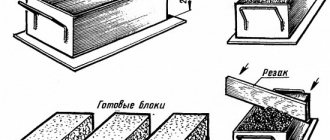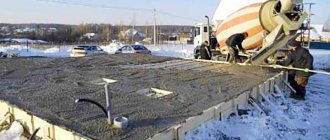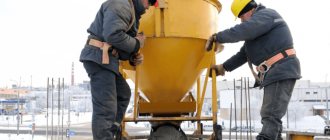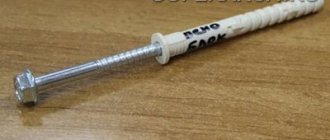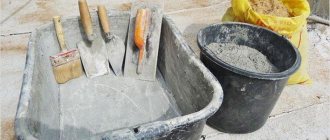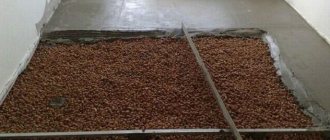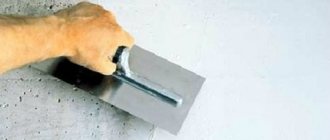The question of at what temperature concrete can be poured is very important, since not only the technical and operational characteristics of the hardened monolith, but also the general probability of undergoing the hardening process largely depend on it. Concrete poured at the wrong temperature or frozen during hardening can become covered with cracks, demonstrate lower strength and durability in comparison with standard values, and cause deformation or complete destruction of the structure or building.
In order for concrete to gain its design strength and guarantee a long service life, it is very important to observe the temperature regime both at the time of pouring and throughout the entire curing time (28 days). The optimal air temperature is around +20 degrees. But it is not always possible to meet this condition on a construction site.
Quite often it becomes necessary to pour concrete at sub-zero temperatures or during the work the weather suddenly deteriorates. In such cases, different methods of heating the concrete are used, anti-frost additives are introduced into the mixture, the structure is insulated directly on the site, etc. Before using any of this heating methods, you must carefully study its features and implementation conditions.
The process of strengthening concrete structures
To determine to what temperature concrete can be poured, it is necessary to first, at least superficially, consider the features of the process of gaining strength by a monolith. The reaction begins to occur between cement/water at the moment of mixing. In the first hours, the concrete is still fluid and can be worked with, but after several hours it begins to harden, becoming first thicker and then completely hard.
The process of interaction between water and cement is called hydration. Hydration takes place in two stages: first the mixture sets, then hardens. Aluminates are involved in setting, and needle-shaped crystals appear, interconnected. After 6-10 hours, these crystals become a kind of frame, skeleton. The concrete begins to harden.
The entire setting process can take from 20 minutes to 20 hours, which directly depends on the ambient temperature. The process takes the longest in the cold season - when it’s about 0 outside, the concrete begins to set in 6-10 hours, the stage lasts 15-20 hours.
During the hardening process, clinker minerals react with the water in solution, and a silicate structure is gradually formed. The reaction provokes the appearance of small crystals, which combine into a unique finely porous structure. This is concrete, which within 28 days already gains brand strength and durability without changing its shape and structure.
Technological solution: antifreeze additives
Modern cement mixtures are protected from the negative effects of frost by special antifreeze additives included in the composition: sodium chloride, calcium chloride, sodium formate, etc. For ground work in the open air, sodium nitrite (up to −15 ° C) or potash (up to −30 °С). Under the influence of salts, the water does not have time to freeze, giving the solution the opportunity to harden correctly and in a timely manner. The main thing is to strictly adhere to the rules for using such mixes:
- the solution temperature is not lower than plus five degrees Celsius;
- do not freeze the prepared astringent product;
- apply immediately after preparation.
In order to speed up the strength gain of the building mixture, additional plasticizers can be added to it, which increase its density and resistance to the vagaries of winter. They should be mixed with water. The amount of plasticizer depends on the purpose of the solution.
The influence of negative temperature on concrete hardening
As mentioned above, the rate of hydration is very dependent on the ambient temperature. Thus, when decreasing from +20 to +5 degrees, hardening occurs on average 5 times slower. Further, the lower the temperature, the slower the reaction. When the temperature reaches sub-zero, hydration stops altogether (the water simply freezes).
At the moment of freezing, water tends to expand, which causes an increase in pressure inside the concrete solution and destruction of already formed crystal bonds. The structure of concrete is destroyed and cannot be restored in the future. In addition, ice that appears in the mixture can envelop large fillers, destroying adhesion to cement. All this significantly worsens the solidity of the structure and reduces strength.
When the water thaws, hardening continues, but the structure of the concrete is already deformed. Delaminations, deformations, cracks may appear, and separation of large fillers and reinforcement from the monolith may occur. The earlier the freshly poured concrete freezes, the lower the strength indicator will be.
Under what conditions should concrete not be poured?
- When the ambient temperature is at +5 C and below, and no measures to warm up or increase the frost resistance of concrete are planned.
- In the off-season - when the temperature is unstable, there are strong jumps in both the marks on the thermometer and the humidity.
- If the thermometer shows a temperature of +25 degrees or higher, and air humidity is below 50%. At such times, it is better to use special cements or not carry out work, since the hydration process will occur very quickly: the water will evaporate, and the concrete will not have time to gain strength, as a result of which cracks, deformations, peelings, etc. often appear.
- Pouring concrete at sub-zero temperatures without warming up for at least 3 days up to +10-30 degrees.
- When concrete with special additives has already been prepared, and a thaw suddenly sets in outside the window or the air humidity becomes above 60%, it starts to rain, etc.
- In case of inability to determine the optimal heating mode, set up devices, control concrete in cold weather. After all, both frost and overheating are equally dangerous for concrete.
At what optimal temperature can concrete be poured?
- From +5 to +20 degrees are normal conditions for pouring concrete prepared according to a standard recipe.
- From zero to +5 degrees - exclusively with the use of special additives.
- From 0 to -20 degrees - with special additives and heating.
- Ideal conditions are concrete temperature +30 and air temperature +20, humidity up to 100%.
Thawing winter masonry
When, after winter hardening, the mortar in the erected wall begins to thaw, a sharp loss of stability occurs.
And in the case of uneven thawing, it even leads to deformation of the wall. Due to this, it is important to control the process and carry out timely measures to maintain the stability of the erected structure. When the masonry is laid using the freezing method, during its thawing, they carefully monitor how it occurs. More attention is paid to the power elements on which the stability of the entire erected structure depends.
It is necessary to monitor the condition of the constructed masonry until the thawing ends, and constant above-zero temperatures set in. Due to the fact that the walls of the building, located on different sides, are not evenly heated by nature, it is recommended to cover the northern side with parchment. This will create equal conditions and a uniform thawing process Date: 01/09/2015 Comments: Rating: 26 Construction work is a rather labor-intensive process, but in winter it becomes more complicated. In order to make and use winter mortar for bricklaying, you need to know a number of features. Brickwork diagram.
Concreting in winter
It may be necessary to use concrete in cold weather in a variety of cases - when it is unprofitable to stop construction for an entire season, in case of emergency work, etc. Taking into account the detrimental effect of sub-zero temperatures on the material and its technical characteristics, concrete must be heated. When the temperature inside the solution is higher than the temperature outside, deformations may occur.
The concrete is heated until a critical strength indicator is reached. If such data is not in the design documentation, then the value is taken as 70% of the design strength. When there are requirements with waterproof/frost resistance values, then the critical strength is 85% of the design.
The main methods of heating concrete for pouring at minus temperatures:
- Warming up the components themselves to prepare the mixture.
- Using the thermos effect.
- Implementation of electric heating.
- Application of steam heating.
Thus, there is no question at all at what minimum temperature concrete can be poured. The task is to optimally prepare the mixture and the object in accordance with the working conditions to preserve the technical properties of the material and the basic requirements for strength, reliability, and durability.
The simplest and cheapest option is to heat up all the components used to prepare concrete. They are heated so that at the time of pouring the concrete has a minimum temperature of +35-40 degrees.
All materials except cement are heated: crushed stone/sand up to +60, water up to +90, cement is simply left in a warm room for a while (so that it is at room temperature). Then mix all the components and fill.
Thermos method
This option is relevant in the case of pouring massive structures. Additional heating is not provided, but the mixture being laid must exhibit a temperature of at least +10 degrees (preferably more). This method consists in allowing the poured mixture to acquire critical strength during the cooling process.
The principle of this method is that the concrete reacts and begins the hardening process, which is exothermic (that is, accompanied by the release of heat). Thus, the concrete will self-heat. If heat loss is excluded, concrete can warm up to +70 and above.
The formwork is reliably protected with heat-insulating materials, eliminating heat loss from concrete that is in the process of hardening. Water does not freeze, the concrete monolith gradually gains strength without destroying the internal structure. This option is used for pouring foundations in winter; it is considered the simplest and most economical, since it does not require the use of any equipment.
Electric heating of concrete mixture
When thinking about the temperatures at which concrete can be poured, many consider electric heating as a way out of the situation. Warming up can be carried out using several methods: using electrodes, the induction method and various electric heating devices.
Heating by electrodes is carried out as follows:
- Electrodes are introduced into the freshly poured mixture.
- Then current is applied to the electrodes.
- As current passes through the electrodes, they heat up and transfer heat to the concrete.
The current must be alternating, since a constant one will cause the electrolysis process, which is accompanied by the release of gas. The gas shields the surface of all electrodes, the current resistance increases significantly, as a result of which heating is noticeably reduced. If reinforcement is laid in concrete, it can be used as an electrode.
Application of cement mortar
When the powdered material is mixed with water, a chemical reaction called hydration begins. In its process, a plastic substance is first formed, and then it petrifies. The first stage is called setting, the second - hardening. The powder particles are surrounded by water, to which 50 to 70% is added. Next, needle-shaped crystals appear. After approximately 6 hours, bonds form between the crystals - this is setting. At this stage of cooking, the ambient temperature is of great importance. The lower it is, the longer the setting takes. But when the temperature crosses 30 degrees, the process slows down. Hardening proceeds to a gradual increase in strength.
Cement changes physical properties with the release of heat. The maximum heat is observed at the end of the process.
How quickly hydration occurs depends on several factors:
- amount of water;
- temperature;
- introduction of additives.
Moreover, the hardening process lasts not hours, but years. The cement mortar reaches its maximum value after 1-5 years.
To use cement mortar with confidence in the final result, pay attention to the following properties of the material:
- degree of grinding - the higher it is, the stronger the finished structure;
- corrosion resistance - determines how well a substance will withstand the destructive influences of the environment;
- resistance to low temperatures;
- the need for water for quality hydration;
- strength, as indicated by the brand;
- sulfate resistance – resistance to water containing sulfate ions.
There are several marks on the packaging, from which one can draw a conclusion about the properties of the building material. The marking contains information about the type of cement - it is indicated by the first two letters. Compressive strength is identified by the digital designation after the letter M - for example, M300.
Manufacturers also indicate whether they contain additives. If they are missing, this is indicated by the DO marking. When the volume of additives reaches 5%, the packaging bears the designation D5. If they are within 5-20%, the product is marked with D20.
Additional information about the product is also provided - about its special properties. For example, if it is a cement mortar that hardens quickly, it is identified by the mark B. Hydrophobized material is marked with the letters GF.
The production of a popular building material can be described in several steps:
- extraction of raw materials;
- transportation of raw materials to the plant;
- grinding components;
- clinker firing;
- secondary grinding - to a powder state;
- introduction of additives into the composition;
- packaging
The most labor-intensive are the first two stages of production. The profitability of an enterprise is determined by how far away from it the quarries where raw materials are extracted are located. Therefore, to increase the readings, factories are built near mining sites, when such an opportunity exists. Limestones and clay with a certain composition are used as raw materials.
The key differences in the production process lie in the way it takes place. There is a dry and wet method. In the first case, the clinker is prepared in a dry state, and in the second, by grinding in water.
To properly use the mixture, you will need to study the extensive classification of building materials. Its purpose also depends on the type. The following common options are available:
- quick-hardening Portland cement;
- sulfate-resistant Portland cement;
- with surfactants;
- with water-repellent components;
- white Portland cement;
- colored Portland cement;
- cement Portland cement;
- pozzolanic Portland cement;
- slag mixtures;
- aluminous composition;
- expanding mixtures;
- tension material;
- waterproofing;
- high strength.
Depending on the additives, the product can be zinc phosphate, magnesium, silicophosphate, etc. Each component imparts its own properties, which are taken into account when choosing, depending on the place and method of application of the mixture. For example, elasticizers are introduced into the mass to increase elasticity and adhesion, and plasticizers are added to increase mobility and reduce the tendency to delamination. Waterproofing agents increase setting speed and improve water resistance. Latex additives impart a number of valuable properties: resistance to water, oil and petroleum products.
The brand of building material designated by the letter M with numbers is a designation of its strength. It is predetermined experimentally by creating a parallelepiped from concrete, which is physically influenced, calculating what maximum load it can withstand.
The packaging with the mixture subsequently indicates how durable the material is. If it says M300, this means that the load reaches up to 300 kilograms per centimeter. Accordingly, the higher the number after the letter M, the stronger the building material will be.
For example, grades M400-M500 are used in the construction of foundations. The M200-M300 grades are suitable for making plaster and performing various finishing works. M600 is a military product. It is distinguished by maximum strength, which also leads to high cost. Therefore, it finds application in the construction of bunkers and similar structures.
It should be borne in mind that as the material is stored, it loses strength. On average, it becomes lower by 10% within a month. But it all depends on the storage conditions: the higher the air humidity, the more the mixture suffers. This should be taken into account when compiling the proportion of cement-sand mortar according to the instructions.
Using additives in cold weather
Today, the use of antifreeze additives and special chemical accelerators for concrete hardening is very common. Most often, these additives are sodium nitrite, chloride salts, calcium carbonate and others. Additives significantly lower the freezing point of water and activate the hydration of cement (thus increasing the pour point of concrete).
By adding additives to the mixture, the need for heating can be avoided. Some additives can increase the resistance of concrete to frost so much that the question of whether concrete can be poured at subzero temperatures is not worth it at all: hydration takes place even at an ambient temperature of -20 degrees.
But, despite all the advantages, additives also have some disadvantages.
What you need to remember when introducing additives into concrete:
- They have a detrimental effect on the reinforcement - the corrosion process can begin, so it is important to introduce additives only into unreinforced concrete.
- Additives allow the concrete to gain strength equal to a maximum of 30% of the design value, and then when the mixture thaws (at positive temperatures), the process of strength gain continues. In this regard, according to SNiP, additives cannot be introduced into concrete operating under dynamic loads (hammers, vibrating machines, etc.).
Main types of antifreeze additives:
- Sulfates actively release heat, accompanying the hydration process. They bind strongly to poorly soluble compounds; they cannot be used to lower the freezing point of the mixture.
- Antifreeze - reduces the crystallization temperature of the liquid, increases the rate of setting of the solution, does not affect the rate of formation of structures.
- Accelerators - increase the solubility of silicate components of cement, they react with hydration products, create basic and double salts, which lower the freezing point of the liquid in the solution.
The most common antifreeze additives:
- Calcium carbonate (potash) is a crystalline substance, an antifreeze component that accelerates setting and hardening. Reduces the strength of a concrete monolith by 20-30%, so it is usually combined with sulfide-yeast mash (sodium tetraborate) at a concentration of a maximum of 30%.
- Sodium tetraborate (sulfate-yeast mash) is a mixture of calcium, sodium, ammonium salts or lignosulfonic acids. The additive is used as an admixture to potash and prevents concrete from losing strength.
- Sodium nitrite is a crystalline powder, a toxic, fire-hazardous substance, used in the construction of multi-story buildings, it dissolves easily, does not destroy reinforcement, and increases the hardening rate by 1.5 times.
- Calcium or sodium formate - used with plasticizers in a volume of no more than 2-6% by weight of the solution. Added during the kneading process.
- Ammonia water is a solution of ammonia in a concentration of 10-12%, does not provoke metal corrosion, and does not cause efflorescence.
Folk remedies
Some people add regular automotive antifreeze to the mortar to give it the desired properties. But after introducing it into the composition, it is necessary to constantly monitor the quality of hardening. Otherwise, the cement mortar will not harden correctly.
To do this, do-it-yourself winter brickwork must have a small number of nests in which plugs will be inserted. After their removal, it becomes possible to measure the temperature of the solution in this area. Due to this, the condition of the cement and hardening are monitored.
It is necessary to build walls when the masonry mixture for bricks is supplemented with antifreeze, carefully and taking the necessary precautions.
This is due to the fact that such inclusions belong to inorganic solvents, as well as mineral salts. Therefore, during the masonry process, workers must use protective clothing, gloves, and face and eye protection. Failure to comply with these measures results in chemical burns.
Concreting in dry, hot climates
Concrete does not like not only frost, but also heat. When the air temperature rises to +35 and above, and the humidity is at 50%, water evaporates too quickly, which provokes a violation of the water-cement balance. Hydration slows down or stops altogether, and therefore the concrete must be protected from too rapid loss of moisture.
To lower the temperature of the mixture, use chilled (or diluted with ice) water. This prevents rapid evaporation of water during the laying of the mixture. After a certain time, the mixture heats up, so it is important to ensure the tightness of the formwork (so that water does not evaporate through the cracks). Formwork can also absorb moisture, and therefore, to limit the adhesion of concrete and structural material, it is treated with special compounds before pouring.
Hardening concrete is protected from direct ultraviolet rays - the surface is covered with tarpaulin (burlap), and the surface is wetted every 3-4 hours. Moisturizing may be necessary during the entire 28 days of the monolith gaining strength.
The following method is often used to protect concrete from heat: an airtight cap made of PVC film with a thickness of at least 0.2 millimeters is created above the surface.
Concrete prepared according to the recipe is able to set, harden and acquire all design characteristics at an ambient temperature of +20 degrees and a humidity of about 100%. If work is carried out in frost or heat, it is necessary to take care of heating or cooling measures that will guarantee the strength and durability of the finished structure.
Storage features and temperature conditions
To ensure the safety of cement in winter, it is necessary to take into account humidity parameters and air temperature. Exposure to snow and frost will lead to the death of the building material. Within a day it will turn into a useless mass.
The recommended humidity level for cement preservation is 50-60%. The temperature should be no less than + 5 C.
In such conditions, unopened bags can be stored according to the GOST expiration dates; if the container has been opened, the shelf life is reduced. Every month, cement from an opened package loses about 15% of its properties. Cement loses the same amount from a whole package, but in three months.
If it is impossible to provide the necessary storage conditions, you should avoid purchasing material in large quantities.
Storing cement indoors
A suitable room is considered to be one in which temperature and humidity conditions can be ensured. The room must be absolutely dry and not freezing. A prerequisite is the possibility of ventilation, without which the humidity of the room increases.
Cement should not be stored in winter conditions in a cellar, basement or underground. A garage or any other utility room without heating is also not recommended. Cement should not be stored in a cold room in winter.
Methods for storing cement indoors:
- On pallets. Euro pallets or self-made flooring from boards are suitable.
- In a barrel or container.
Cement should be stored on pallets in winter.
Preparation of cement for winter storage in bags on pallets includes the following operations:
- Wooden pallets should be raised above the floor by about 30 cm. Bricks can be placed under them to ensure this height.
- The distance to the wall from the pallet should be at least 30 cm.
- Whole or opened bags are wrapped in plastic wrap. For an open bag, you need to carefully seal the hole with tape.
- The containers are placed on a pallet in a stack, ensuring the rows can be laid out in a rotating manner. The first row is laid out along the pallet, the second across.
- Cover the top with a tarpaulin, leaving open the side close to the source of air intake for ventilation.
- The bags must be turned over once every 2 months.
You can store cement in a barrel as follows:
- Check the tightness of the container or barrel.
- Pour cement, cover with a layer of sand on top.
- Close the container and wrap it in plastic wrap.
Cement cannot be stored in a barrel for long; this is a temporary measure.
It is important to consider the following: storing cement of different brands together is not recommended. A separate pallet is allocated for each brand.
On the street
It is almost impossible to store cement in bags outside in winter, since there is no guarantee of weather stability.
Outdoor conditions are suitable for short-term storage at temperatures above + 5 C. In order to protect the material from wet and dry snow, you need to do the following:
- Place pallets under the canopy.
- Place the bags on a pallet, covering each row with polyethylene.
- Cover the top with another layer of polyethylene, securing it along the edges.
If there is no canopy, then the top of the stack is covered with a tarpaulin.
You can store the dry mixture in this way for several days if the weather does not change.
How to choose the time of year and up to how many degrees you can lay bricks
Up to how many degrees can masonry be done? In the cold season, it is difficult to start building a building, since creating a building in freezing temperatures takes a significant amount of time and requires the use of additional equipment. At minus temperatures, almost any liquid freezes, which complicates the process of preparing cement mortar and other mixtures.
Due to a large number of difficulties, only a small part of developers decide to erect a building in the cold.
If there is an urgent need for construction in winter, if the workers have the appropriate level of skill, as well as the possibility of purchasing or renting additional equipment, this task is feasible.
You must follow the rules for preparing the solution and pay attention to certain nuances of the work so that the finished building looks presentable and is reliable.
In order to be guaranteed of the high quality of the brickwork, it is necessary to carry out construction work only in positive weather, and also to control the optimal level of air humidity.
Cement today is the most common material used in construction and renovation. Here are the characteristics and features of M400 cement.
Without tile adhesive today it is impossible to finish indoors. Here you will learn about the consumption of tile adhesive.
Choosing the time of year
High-quality brickwork is performed only at positive temperatures and normal air humidity. The lower the reading on the thermometer, the worse the brickwork mortar hardens, and at minus values this process stops.
You can learn how to use single solid building brick m 150 from this article.
At low temperatures, the water contained in the cement composition can freeze and turn into ice. Therefore, there can be no talk of any interaction of chemical components.
What is the size of a single brick is indicated in this article.
If the reaction managed to occur before the frost and the solution holds the masonry, it may turn out that it did not harden, since it was prevented by the same water, which turned into ice. Because of its shape, it lost its usual plasticity, and the seams between the bricks were poorly sealed. After thawing and hardening of the cement composition, the strength characteristics of the brickwork are noticeably reduced.
